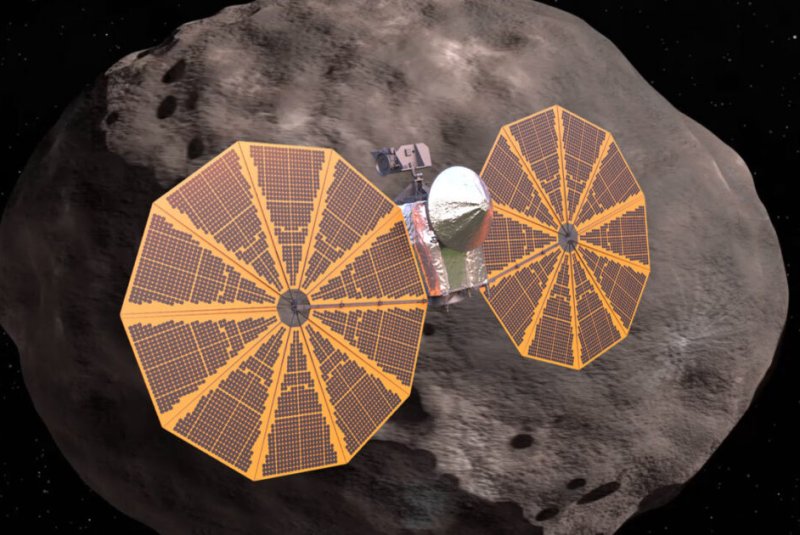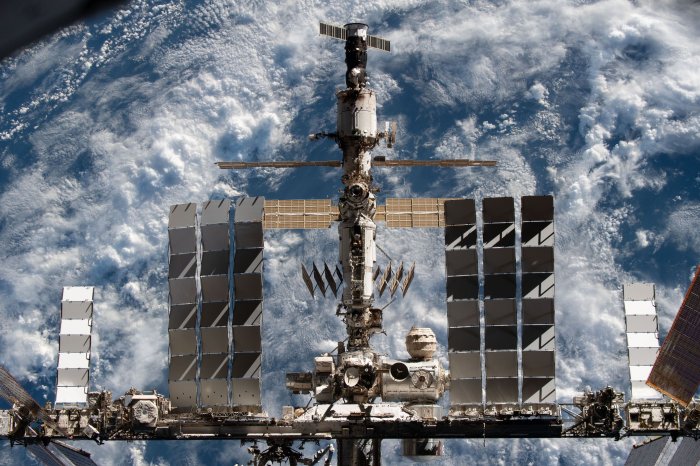1 of 5 | An illustration depicts the Lucy spacecraft near an asteroid in the Trojan Belt area of the solar system. Image courtesy of NASA
Sept. 28 (UPI) -- NASA plans to launch its Lucy spacecraft from Florida on Oct. 16 to fly by eight asteroids starting in 2025, marking the first time scientists will gain close-up views of them.
The spacecraft for the $981 million mission is at Kennedy Space Center for launch preparations, which include packing atop an Atlas V rocket for its 12-year voyage. United Launch Alliance plans to send the probe into space from adjacent Cape Canaveral Space Force Station.
Lucy will pass by a single asteroid in 2025 on its way to Jupiter's orbit, where its complex trajectory will take it by seven more asteroids in the so-called Trojan Belt.
The trip will be the first time any spacecraft has visited the Trojan asteroids, Lori Glaze, director of NASA's Planetary Science Division, said Tuesday during an online press conference.
"By studying the Trojan asteroids, we can gain more insight into the history of the outer solar system and the giant planets Jupiter, Saturn, Uranus and Neptune," Glaze said.
The Trojans are debris left from the formation of those planets, and NASA believes they haven't changed since the dawn of the solar system's planets, she said.
Lucy will travel billions of miles on its journey to the Trojan asteroid orbit, which is similar to Jupiter's at more than 400 million miles from Earth.
The spacecraft is about 43 feet long and has two very large disc-like solar arrays about 24 feet in diameter. More than 500 engineers and technicians built it at Lockheed Martin's plant in Littleton, Colo., where they assembled more than 430 components and more than 2 miles over wire, said Rich Lipe, the Lockheed Martin spacecraft program manager.
The large solar arrays are needed because Lucy will spend more than a decade so far from the sun. According to NASA, the solar arrays must open flawlessly soon after launch to provide Lucy with the power supply it will need.
After spending years to reach the asteroids, Lucy will attempt to fly within 600 miles of them, said Keith Noll, a NASA planetary astronomer and Lucy project scientist. The spacecraft will scan the rocky space objects with three instruments.
"Lucy doesn't slow down. It will be moving anywhere between 3 and 5 miles per second relative to the asteroids," Noll said. "The very best data will be collected in just a few hours during the closest approach."
The mission takes its name from the fossilized human skeleton found in Africa in 1974 that provided unique insight into humanity's evolution, according to NASA. The skeleton was named Lucy because teams of excavators at the discovery site routinely played the Beatles tune Lucy in the Sky with Diamonds.
Like the skeleton, the Lucy mission is geared to revolutionize knowledge of the past and formation of the solar system, according to NASA's mission profile.
Scientists will pore over Lucy's data for decades, said Hal Levison, a planetary scientist and a principal investigator on the mission, who is with the non-profit Southwest Research Institute based in San Antonio.
"The asteroids chosen for this are very physically different from one another," Levison said. "For example they have very different colors." He said that diversity should ensure that Lucy obtains a range of information about the Trojan asteroids.
The International Space Station is pictured from the SpaceX Crew Dragon Endeavour during a flyaround of the orbiting lab that took place following its undocking from the Harmony module’s space-facing port on November 8. Photo courtesy of NASA
















